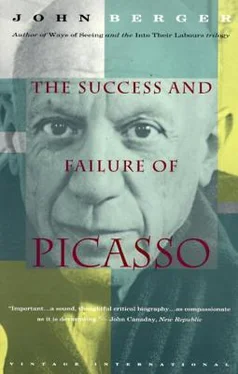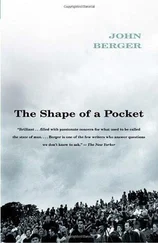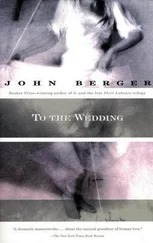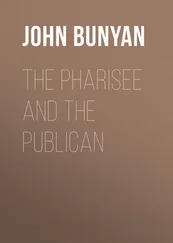What is said is not untrue. It is simply irrelevant. (What might be relevant is why painters paint beggars, what is special about the Spanish attitude to poverty, how the age of a man changes the clothes he wears, whether or not Picasso when he painted this at the age of fourteen was already becoming aware of the inadequacy of the provincial, illustrative style of drawing he had been taught, etc.) There is a total inability to see the work in relation to any general human experience. Instead, the picture is described, identified, and given a good pedigree as an object; whilst Picasso — at the age of fourteen — is set at Velazquez’ right hand and glorified as a phoenix-like genius.
Yet although this Romantic illusion has been preserved in the bourgeois attitude to art, it has not continued to be accepted by artists. For the early Romantics it was a working hypothesis of faith which allowed them to continue working. By the middle of the nineteenth century — and increasingly towards the end — a new and more realistic hypothesis was being put forward. The power of the bourgeoisie would not last for ever. Society was changing or would be changed. The future would therefore be different. From this one could draw the conclusion that the important artist was ahead of his time. Stendhal was among the first to draw this conclusion when he prophesied that his work would start being read in 1880 and appreciated in 1935.
From Stendhal onwards every major artist, however Romantic he may have been in other respects, believed that his works — the only things which could survive in the future — were the justification of his life. He struggled to put all of himself into his work; his creative spirit, in so far as he thought about it, was merely his ability to do this, to transform what he was into what he made. This is as true of Flaubert as of Cézanne or Gauguin or Seurat or Van Gogh or Rodin or Yeats or James Joyce. A few minor artists — like Maeterlinck — played with reviving the romantic illusion about silence being more musical than sound; but it was no longer a means of working: it was a way of graciously accepting defeat at the hands of the world.
The important artists of Picasso’s generation shared the attitude of their predecessors. Indeed part of their admiration for Van Gogh or Cézanne was due to their sense of having inherited their work, which it was now their duty to continue and develop further. All the emphasis was on what had been and had to be done. As they became highly successful — like Matisse or Braque — they may have needed to believe in their justification by working less urgently. But one has only to read those who, like Juan Gris or Apollinaire, died before such success came, to realize how fundamental to this generation was their conviction that it is what the artist does that counts. A little before he died in 1918, Apollinaire wrote an essay on the new spirit of the poets.
There is the material the poet has collected, the material the new spirit has revealed, and this material will form the basis of a truth the simplicity of which will be undeniable, and which will lead to great, very great things.
The life-line runs through the work.
But not for Picasso. Picasso is the exception. ‘It’s not what the artist does that counts but what he is.’
We have here the first indication of Picasso’s historical ambiguity. He is the most famous painter in the world and his fame rests upon his modernity. He is the undisputed emperor of modern art. And yet in his attitude to art and to his own destiny as an artist there is a bias which is not in the least modern and which belongs more properly to the beginning of the nineteenth century.
Furthermore there seems to be a connexion between this historical ambiguity and the nature and scale of his success. The popular myth of Picasso, supported by the evidence of his friends, is not in fact such a gross distortion of the truth as seen by Picasso. Picasso’s own Romantic belief in genius as a state of being lends itself to the myth. The working attitude of any of his great contemporaries, their temperamental treatment of themselves, would never have fed the myth with enough material. But with Picasso’s example it is only a few steps from genius as a state of being to the divinity of the demi-god.
I don’t want to suggest that Picasso’s legendary character is simply the result of his own opinions about what it means to be an artist. He has an extremely powerful personality which provokes legends. Perhaps he is a little comparable in this respect with Napoleon. Certainly he has a similar power of attracting and holding allegiance. He is very seldom criticized by those who know him personally. What Picasso is, apart from what he does, is indeed remarkable — and perhaps all the more so for being indefinable. It is not how he speaks or acts that seems to be so memorable: it is his presence — the hint of what is going on inside the man.
In recent years all accounts of Picasso as a personality have become absurd. He has surrounded himself with a court, and he is king. The effects of the consequent flattery and insulation have been devastating, not only on the judgement of all those who know him, but on his own work. A special kind of sickening poeticizing has been invented for the homages. Thus Georges Besson wrote in 1952:
I almost forgot to tell you — or have I told you already? — that this man, whose tastes are not extravagant, has a weakness for black diamonds. He owns two superb ones and he will never part with them. They weigh a good hundred carats each. He wears them where other people have eyes. It’s as I tell you. And I assure you that those women on whom these diamonds turn their fire are utterly bowled over.
But before he had courtiers, those who wrote about Picasso found his eyes particularly remarkable. Fernande Olivier, describing how she first met him in 1904, wrote:
Small, black, thick-set, restless, disquieting, with eyes dark, profound, piercing, strange, almost staring.
His eyes [wrote Gertrude Stein, referring to about the same period] were more wonderful than even I remembered, so full and so brown, and his hands so dark and delicate and alert.
In 1920, when Maurice Raynal was disappointed with Picasso’s latest exhibition, he wrote: ‘Some of the stars in his eyes have gone out.’
The eyes in the head become a symbol for the whole man.
In the films about Picasso you can see his eyes for yourself. They reveal — or so it seems to me — the inordinate intensity of the man’s inner life and at the same time the solitariness of that life.
Little by little we are being forced to consider the general nature, the trend of Picasso’s subjective experience. How to define this spirit which he himself values more than his work, which charges his presence, and which burns in his eyes?
Picasso was born in Malaga in 1881. From Malaga you can see the Atlas mountains and, when the wind is in the south-east, you can smell the desert. Picasso’s ancestors, on both sides of his middle-class family, had belonged to Malaga for several generations. In 1900, when he was nineteen years old, Picasso left Spain for the first time in his life and spent a few months in Paris. In 1904 he settled in Paris permanently. Between 1904 and 1934 he returned to Spain about half a dozen times on holidays and painting trips. Since 1934, when Picasso was fifty-three, he has never been back. Picasso has spent most of his life in voluntary exile.
Exile is a state which, in its subjective effects, never stands still: you either feel increasingly exiled as time passes, or increasingly absorbed by your adopted country. Picasso certainly adopted France, and France him. His friends were French, he spoke in French, and he came to write in French. He was able to share in French patriotism. (Patriotism — as a result of the three German invasions of French territory in 1870, 1914, and 1940 — was a far more important element in French intellectual life than in English intellectual life during the same period.) France, on her side, recognized Picasso’s genius, and created his reputation for the world to take over in 1945. Nevertheless, and despite all this, I believe that Picasso has felt increasingly exiled.
Читать дальше












